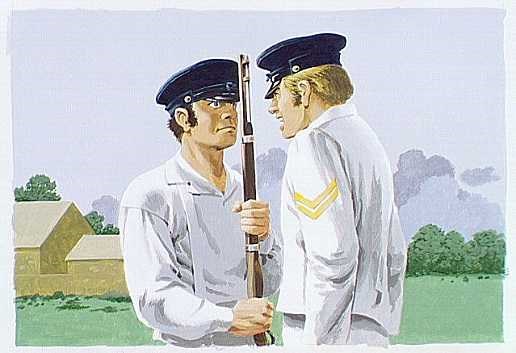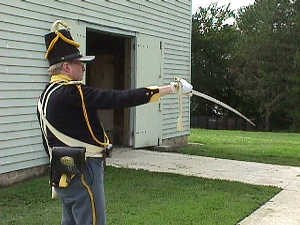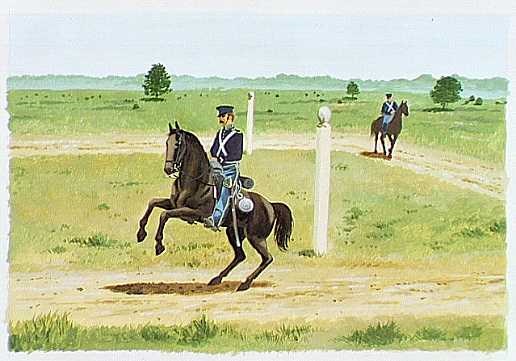
Hugh Brown Becoming a DragoonThe evolution from green recruit to full-fledged dragoon was slow and sometimes agonizing. In his first week, the recruit spent his time learning all the details of discipline, policing, interior services, his uniform, and grooming his horse. A corporal, superintended by a sergeant and an officer, instructed the recruit in mounting without a saddle on both sides of a horse, the names and uses of his weapons and equipment and how to keep them clean, and how to fold his effects to place in his valise. 
NPS School of the Trooper, DismountedCareful attention was given in the meantime to training the dragoon to fight on foot. The lessons were called School of the Trooper, Dismounted, and the first lessons involved learning to march and to have the correct bearing. After this was accomplished, he learned quick step, backward step, the manual of arms, loading, firing, marching with arms at different steps, firing, and use of the saber and lance. The men were taught the use of their sabers and lances, both while marching and at target practice. The latter involved parries and thrusts to be used against cavalry. 
Hugh Brown School of the Platoon, Dismounted and School of the Trooper, MountedOnce the School of the Trooper, Dismounted, had been mastered, the dragoons progressed to the School of the Platoon, dismounted, and the School of the Trooper, Mounted, which were held jointly. Approximately 180 days or six months were spent learning these lessons. The school of the Platoon, Dismounted, mainly taught the men how to march together as a platoon, the movements, counter-marching, wheeling, etc., the manual of arms, firing, saber and lance, and rallying and skirmishing. It was probably the beginning of their training on horseback that met the most enthusiasm of the men. It was an enthusiasm that not even nights of sore and aching muscles could quite dampen. Training HorsesMen and horses trained together. During the first mounted lessons, the experienced horses led off, with remount horses distributed among the older ones so that they could become accustomed to the sight of saddles, accouterments, etc. Noncommissioned officers supervised the saddling of the new horses, which were led out to the drill ground by snaffle-bridles. The instructors also inspected the saddles to make sure the cruppers and girths were not too tight. The men mounted quietly and shouting was not allowed. Young or horses in poor condition were put in separate squads and given less work than the others. Since young horses needed to be encouraged to go forward willingly, the men patted and talked to their animals. Going to and from the stables, horses maintained a distance of six feet to prevent injury from kicking. Remount horses were not ridden, when they arrived at the garrison, but were merely led out during the warmest part of the day by soldiers mounted on trained horses. Only when the animals had recovered from their journey to the post were they ridden and then only at a walk at first. Each company of a Dragoon Regiment had a designated color for its horses, which were A and K, Black; B, F, and H, sorrel; C, D, E, and I, bay; and G, iron gray. Horses of uniform color not only looked better, but new horses were accepted more quickly when they were the same color as the others. Adjusting to Military LifeLife for recruits was a round of drill and trial and error, Some had difficulty adjusting to the strict discipline; others virtually had to learn a new language and become familiar with the customs of a country they had adopted only recently. Seasoned troopers enjoyed the discomfiture of the new arrivals and off duty collected around the parade ground to watch the noncommissioned officers attempt to instill drill in the new men. An instructor, who momentarily let his attention wander, might find the following happening:
Drilling, however, was limited to certain times of the day, as the bulk of the soldier's day was spent performing fatigue or work details. The use of enlisted men on work details had its drawbacks. An officer, observing the marksmanship of the men, commented:
Experience more Life on the FrontierBack to Virtual Resource Center HomeDragoon Soldier PagesOverview | Program Outline | Tools of the Trade | Regulations | Historical Background | Recruitment | Training | Command Structure | Daily Life | Expeditions |
Last updated: May 23, 2022
